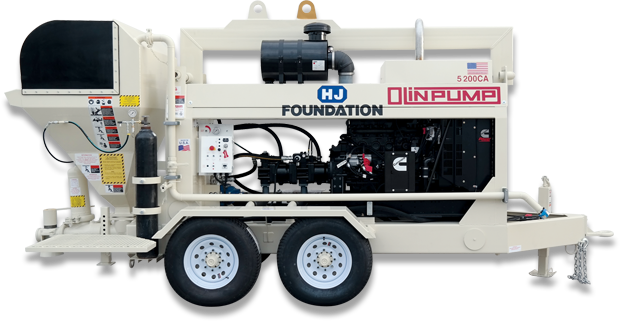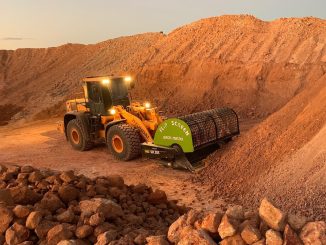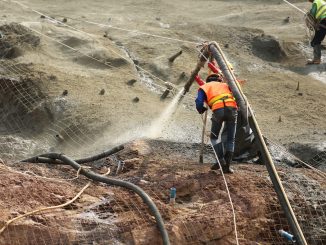View the complete article here.
Pumping concrete is not just for large, commercial construction projects. Even a homeowner building a small patio can save time and money pumping concrete instead of moving it in a wheelbarrow. There are several reasons a project manager should consider concrete pumping on their next job site. There are also many advantages of concrete pumping over other methods. First, we’ll give you some background on concrete pumping. Then we’ll show you how concrete pumping can benefit your bottom line.
What Is Concrete Pumping?
I bet you think it’s just concrete coming out of a pump. True – but an oversimplification. The machine has two cylinders that are fitted with pistons. Liquid concrete is poured into a hopper attached to the machine. The first piston creates air pressure to draw the liquid concrete from the hopper into the first cylinder. At the same time, the other piston pushes the concrete out via a discharge pipe. Then the two pistons swap jobs. This allows the concrete to flow continuously. A valve is used to switch the cylinders between the hopper and the discharge pipe.
Big Business
Concrete pumping is gaining in popularity. According to Trucking info’s September 2019 article Business is Booming for Mobile Concrete Pumps, the industry has grown 14% in the last two decades. 34% of concrete is now poured into place. (45% is still poured directly off trucks and the rest is moved manually by wheelbarrows and buckets.) Concrete pumping is a $1.75 billion business. It is expected to grow nearly 25% by 2021.

Types of Concrete Pumps
Truck Mounted Pump
As the name suggests, the pump is mounted on a truck. It is also known as a boom pump because an articulating robotic arm, called a boom, places the concrete. The boom is maneuvered by remote control. This type of concrete pump is often used on large construction projects. It can pour large volumes of concrete very quickly. The result is a faster, accurate pour. Also, the robotic arm can be used for other tasks, such as electrical and piping repairs.
Trailer, Line, or Stationary Pump
With this style of pump, steel or rubber hoses are attached to the machine, which is mounted on a trailer. Multiple hoses are joined to extend the reach of the pump. Trailer pumps are best for smaller jobs that require the concrete to pumped at a lower volume. Also known as line or stationary pumps, they are used for projects like sidewalks and swimming pools.
Specialized Usage Pump
Specialized equipment is always more expensive. But some job sites, like tunnels, require custom-made concrete pumps. One type of specialized usage pump, though rarely used, is rail-mounted.

5 Reasons to Use Concrete Pumping
So Far Away
You can’t always get the mixer close enough to where you need to pour the concrete. This is common in construction sites located in a city or residential neighborhood.
Labor Shortage
The wheelbarrow is one of humankind’s greatest inventions. But it requires a lot of muscle to move wet concrete around. Even if saving money on labor is not your primary goal, it may be challenging to find enough workers in today’s economy.
Instability
Even if you have enough workers to push around a bunch of wheelbarrows, they can’t readily wheel over uneven or rocky ground that may surround your pour site.
No Swinging Room
You’ll need to use concrete pumping if your pour site is inside a building, at height, or underground.
Behind Schedule
If your project is running over, concrete pumping is much faster and can get you back on schedule.
Benefits of Concrete Pumping
There are many benefits to using concrete pumping, including:
- You can place the concrete farther away and at greater heights.
- You can place the concrete even in bad weather.
- It is easier to pour smaller amounts in multiple locations as some job sites may require.
- It takes fewer workers to pour in place.
- The concrete moves faster from the source to the pouring location.
- It can allow you to get to areas not accessible by crane.
- The time-savings may allow you to complete work on multiple job sites in a day, reducing costs.
Conclusion
There really is no job too big or too small that a concrete pump can’t handle. In most situations, the project manager will find that there are overall cost savings in using concrete pumping on their job sites. Even if concrete pumping is more expensive than other pouring methods, the savings in labor and time can more than offset the service. In some cases, concrete pumping may be the only reasonable solution for challenging job sites.
View the complete article here.
What is the longest and deepest tunnel in the world?
The Gotthard Base Tunnel in Switzerland holds the distinction of being both the longest (35 miles) and deepest (approximately 7,500 feet below mountain peaks) tunnel globally.
Which tunnel is notable for its speedy construction, connecting Suseo to Station in Seoul and Pyeongtaek in Gyeonggi-do Province?
The Yulhyeon Tunnel in South Korea is renowned for its impressive construction speed, connecting Suseo to Station in Seoul and Pyeongtaek in Gyeonggi-do Province in just three years and five months.












































